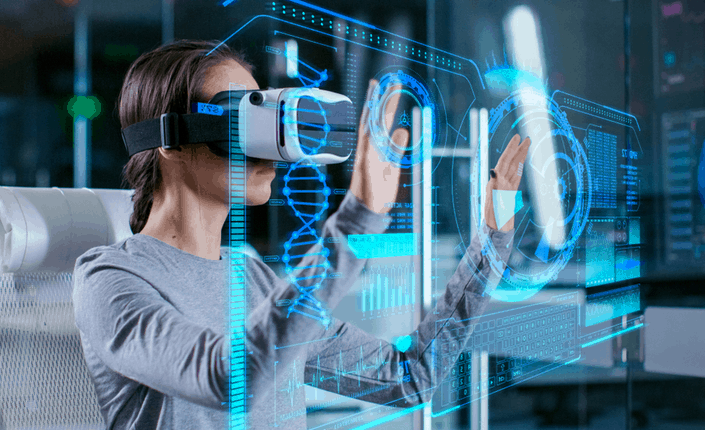
This article was written and published in Spanish and has been translated into English via Google Translate. Click here to read the original article.
"In the case of Virtual Reality, maturity and expectations are aligned and close, which makes it easier for the industry to understand technology and its potential contributions with already clear references, such as training programs. However, this balance is not so close in the areas of Augmented Reality and Mixed Reality, so it is common to identify use cases that technology is not yet able to provide," explains Esther Rodríguez, Advanced Technology Manager at Minsait and responsible for the study "Reality has no limits", which analyzes the future of these technologies.
This alignment between expectations and maturity depends, to a large extent, on the performance of the hardware - that is, on all those devices used to perceive a virtual recreation or interact with these environments.
“More related at the beginning with recreational uses (video games, entertainment), the devices are increasingly oriented towards professional uses where they are gradually introduced into training processes or as support for operations, including dangerous environments,” explains Esther Rodríguez.
As a final conclusion, the Minsait study highlights that price will be a key factor in determining and consolidating the popularity of home-oriented devices, such as mobiles and tablets, which already have the ability to support Extended Reality applications. Likewise, she affirms that this technology will boost relocation as it is tuned towards operational improvement in all businesses and activities in which the worker needs the support of contextual information or any type of reinforcement, including support and distance cooperation.
Less risks and errors
The most entrenched line of training, together with support in production processes and the development of impact solutions to improve engagement and user satisfaction are the main areas in which Extended Reality can provide value and improve efficiency, according to the Minsait report.
In the first case, dangerous or logistically complex scenarios are replaced by virtual recreation to allow operators to complete their training avoiding travel costs and personal risks. Beyond professional instruction, this technology has proven its usefulness in other didactic fields, for example, in overcoming the fear of public speaking by recreating a virtual audience or in the improvement of training techniques for professional athletes.
"Building trust and developing memory through immersive experiences and then applying what has been learned to specific actions in the real world is one of the most powerful contributions of Virtual Reality," says Esther Rodríguez.
On the other hand, the Minsait report highlights the potential of Augmented Reality to develop applications that provide complementary information to the main activity in industrial processes. These are the cases, for example, of mobile devices that show additional information to perform a repair or programs to check the operation of the final version of a vehicle before starting the manufacturing process.
"Augmented Reality is able to optimize any moment of the production chain, increasing the speed of execution and reducing the margin of error, which translates into significant cost savings."
Finally, the report reflects the capacity of any of the three Extended Reality formats to improve the user experience in areas such as tourist visits or as support for commercial actions through the development of 3D virtual models of the products.
“An impact solution results in optimization of the user experience, innovation in commercial work to improve customer acquisition and improve the reputation of the company, associated with innovative technologies."
The keys to success
The study also advances the keys to successfully implement a complete Virtual Reality program taking as reference VIVES, the project developed by Endesa with Minsait as a strategic and technological partner. It is also an illustrative example of how Minsait has transferred to the civil world the advantages of a technology that has established itself as a benchmark for training and training in the Defense and Security market of Indra.
Thanks to this initiative, which has become the best valued course for employees in the last five years, more than 700 professionals in the area of thermal generation of the energy group are training without risk, with greater motivation and more efficiently in the works of management of discharges (physical blockade of equipment).
"The project started from the need for Endesa to implement a new security protocol, LOTO, related to signaling procedures and physical blockages in power plants, introducing an innovation component in the solution in line with the objective of transforming the company formation culture," explains Rodríguez.
For this, it has been necessary to establish a series of steps that range from the technological evaluation of the requirements and adjustment of the use cases, to the functionalities test with end users. Between them, the inspection work was carried out «in situ» and image taking at the operations sites, the elaboration of the project script with details of objectives, scenarios and procedures, as well as the technical development to merge the process logic with the visual component and production from a minimally viable product that incorporates advanced functionalities.
In Esther Rodríguez's opinion, an important success factor of the project has been the alignment between the concept, the pilot and the gradual implementation with products, people and processes to avoid situations such as resistance or the inability of the solution to solve real operational problems.
“As happens when incorporating any other innovative process in the dynamics of an organization, frictions in these key areas can cause the project to stagnate in the initial phase, so it is necessary to follow a methodical sequence that successively covers the proof of concept, the pilot project and the gradual implementation, always taking into account the particularities of each organization and the milestones to be completed in each phase.”
This article was written and published in Spanish and has been translated into English via Google Translate. Click here to read the original article.